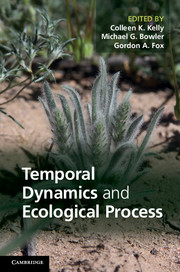Book contents
- Frontmatter
- Contents
- List of Contributors
- 1 Introduction
- Part I Observing temporal processes in nature
- Part II Application to specific questions
- 9 Evolution of synchronised and intermittent reproduction (masting) of trees: key role of regeneration dynamics
- 10 Spatiotemporal variation can promote coexistence more strongly than temporal variation
- 11 Roles of pollinator attraction and environmental fluctuation in inducing flowering synchrony
- 12 Temporal dynamics and the spread of insect resistance transgenes
- 13 Concluding remarks
- Index
- References
12 - Temporal dynamics and the spread of insect resistance transgenes
Published online by Cambridge University Press: 18 December 2013
- Frontmatter
- Contents
- List of Contributors
- 1 Introduction
- Part I Observing temporal processes in nature
- Part II Application to specific questions
- 9 Evolution of synchronised and intermittent reproduction (masting) of trees: key role of regeneration dynamics
- 10 Spatiotemporal variation can promote coexistence more strongly than temporal variation
- 11 Roles of pollinator attraction and environmental fluctuation in inducing flowering synchrony
- 12 Temporal dynamics and the spread of insect resistance transgenes
- 13 Concluding remarks
- Index
- References
Summary
Introduction
Crops can be made resistant to pestiferous insects by genetic modification. The possibility that the modified genetic material may escape into a population of wild relatives is a threat looming over all such endeavours. Since insect infestations fluctuate from year to year, or over longer periods (locusts are an extreme example), the fitness of transgenes escaped from agriculture will be affected by this temporal dynamic and that is the subject of this chapter.
There are two ways in which genetically modified crops may pose a threat to the environment. The first is by spreading beyond arable land and simply outcompeting wild relatives by virtue of the insect resistance modification. The second is by hybridising with wild relatives so that the insect resistance transgene invades and transforms the wild population. The first is unlikely; crops are selected for yield and require tender loving care in order to thrive. The second threat is more insidious and has usually been addressed through population genetics. The role of ecological interactions has been comparatively neglected and the effect on relative fitness of temporal fluctuations in various factors, such as herbivore densities, falls into this category.
- Type
- Chapter
- Information
- Temporal Dynamics and Ecological Process , pp. 282 - 308Publisher: Cambridge University PressPrint publication year: 2014



